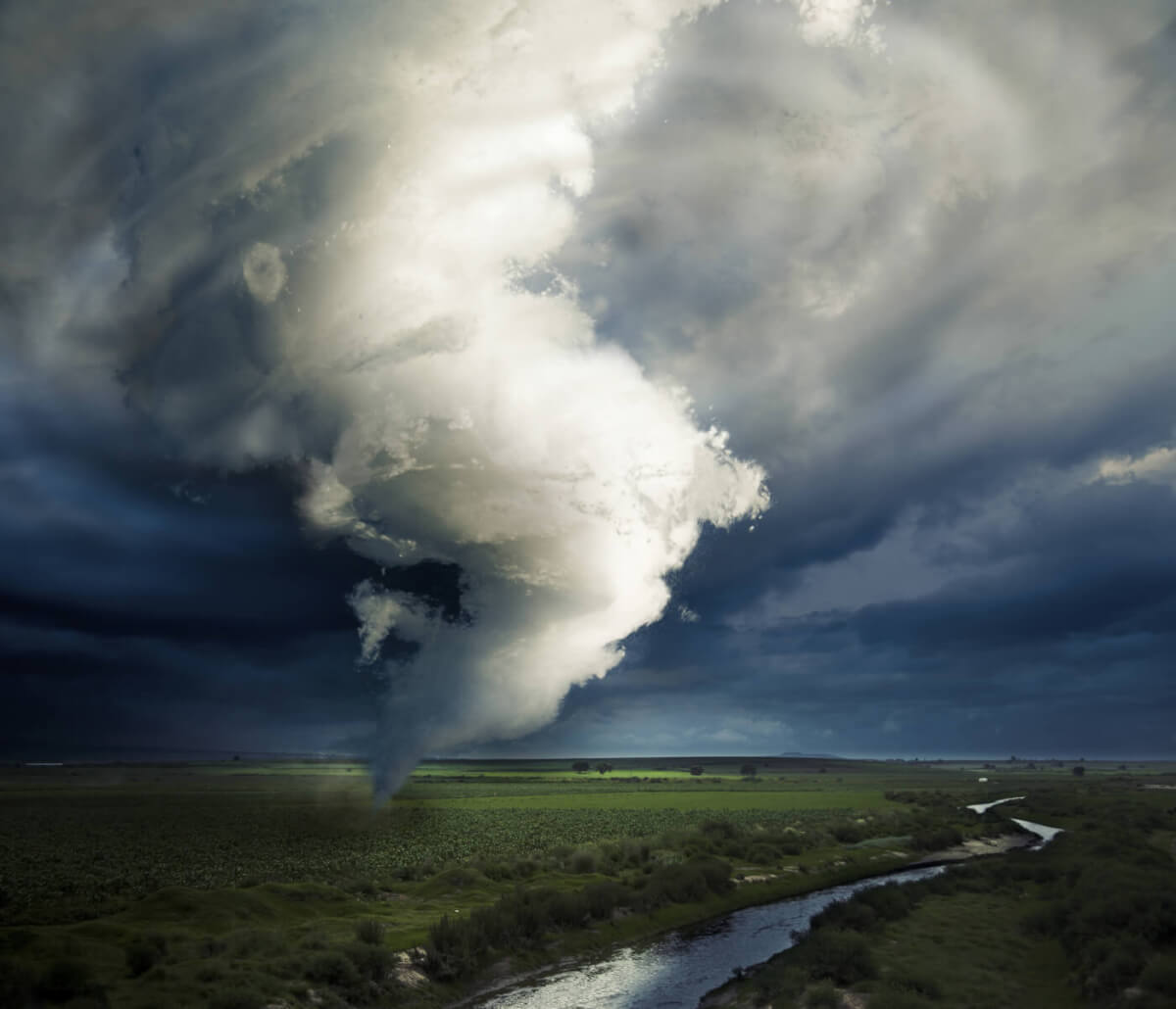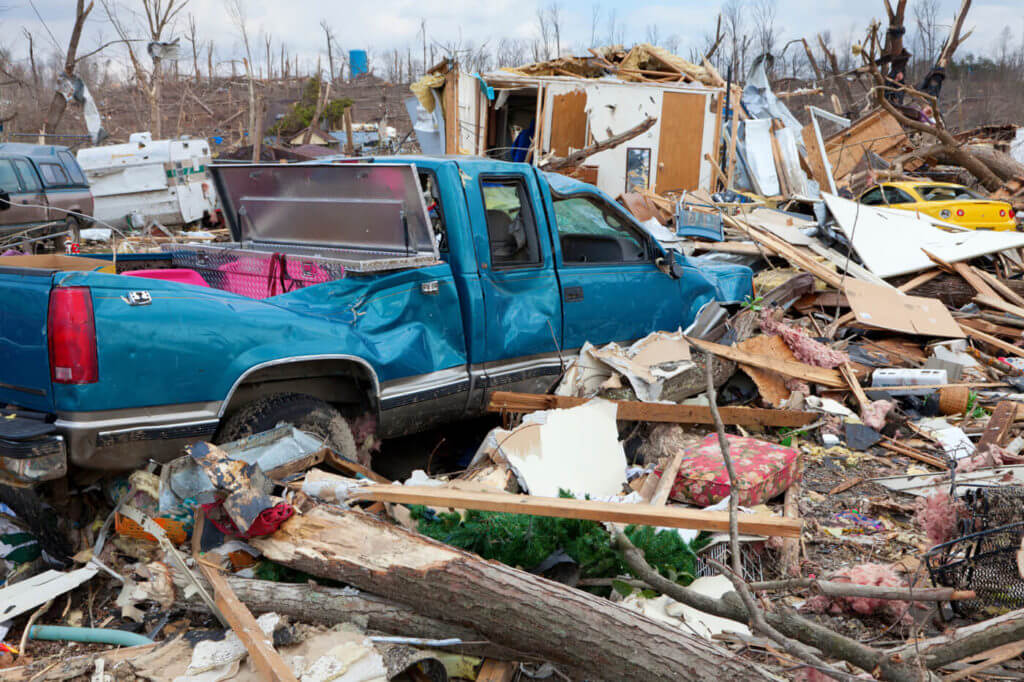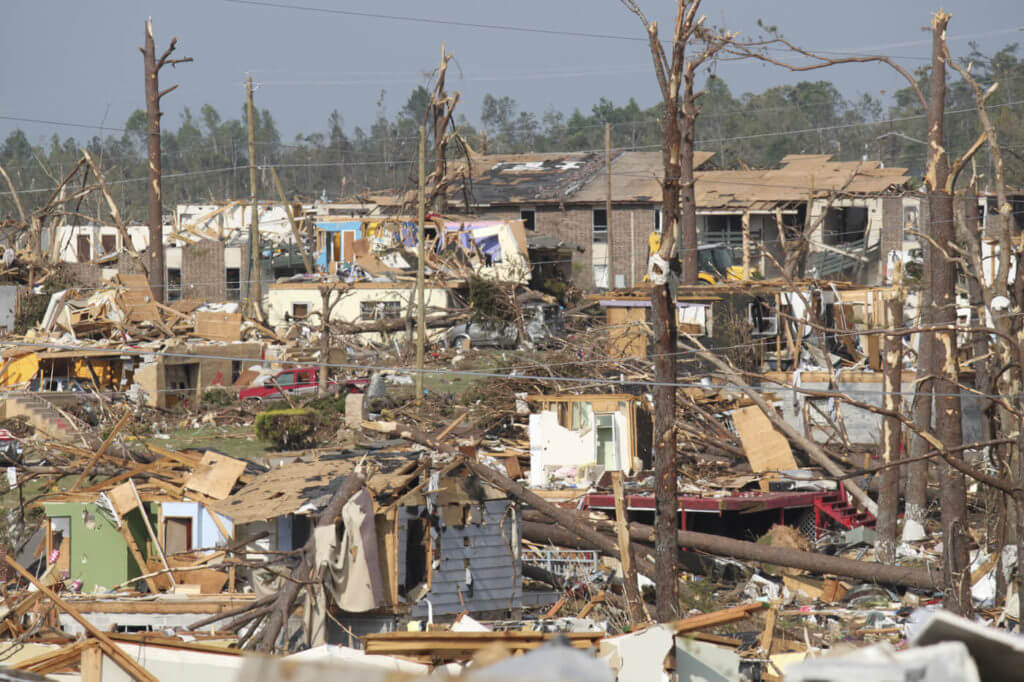Imagine it. A day like any other: outside it’s blue and sunny, nothing out of the ordinary. All of a sudden, clouds begin to form in the sky—puffy, white ones at first—but within minutes, darkly ominous clouds gather overhead and lightning begins flashing every few seconds. A tornado is about to hit and you have minutes, if you’re one of the lucky ones, to prepare yourself. What do you do? Where do you go? How do you stay safe?
Tornadoes are unstoppable forces that occur thousands of times a year around the world. Difficult to prepare for, difficult to escape; these deadly twisters are responsible for billions of dollars worth of damages and hundreds of deaths a year, often leaving behind apocalyptic aftermaths. In one instance, a tornado obliterated a motel in Oklahoma, and people later found the motel’s sign in Arkansas. Tornadoes cause lifealtering damages, and because no place in the country is safe from them (although there are areas more prone to tornadoes), it is important to know the steps for survival.
How Does a Tornado Form?
Each year it is estimated that more than a thousand tornadoes hit the U.S., more than any other country. Tornadoes are aggressive, swirling funnels of air that connect from a cumulonimbus cloud to the surface of the Earth. These twisters come in various forms, including a landspout, multiple vortex and waterspout, although the most common type is a visible condensation funnel.
These tornadoes form from funnel clouds, typically during thunderstorms, but the clouds are not considered tornadoes until they physically touch the ground. The name “tornado” actually comes from the Spanish word tronada, which translates to ‘thunderstorm.’ The twisters are measured by the Enhanced Fujita Scale, which focuses on the damage caused and ranks it from EF0-EF5.
Tornadoes occur more in the United States than another country in the world; in fact, three out of every four tornadoes that occur globally are located in the U.S. The most active area is known as “Tornado Alley,” where more than 500 twisters occur every year. The borders for Tornado Alley are not clearly defined, but it is roughly made up of Texas, Oklahoma, Kansas, Nebraska, South Dakota, North Dakota, Iowa, Missouri, Arkansas and Louisiana. Texas reports more tornadoes than any other state, but this is due to its large size. Per square mile, Kansas and Oklahoma have the most. There is not a set “tornado season” and as long as conditions are right, a tornado can occur anytime of the year.
These deadly storms develop when there are certain conditions in environment at the same time—an abundance of warm, moist air to cause vertical movement of air, atmospheric instability and a “trigger,” which can be a cold front or converging winds that lift moist air.
One of the reasons Tornado Alley experiences so many tornadoes is its proximity to the Gulf of Mexico. The warm, moist air from there collides with the cool, dry air from the Rocky Mountains, which forms a supercell (the type of thunderstorm that produces the twirling updraft of air that results in tornadoes).
Tornadoes carry immense power; some are able to pick up a house and move it down the street. Even less powerful ones are able to destroy cars, send debris flying and cut off vital power lines. The total number of deaths from tornadoes typically varies year to year, depending on the number of tornadoes and the severity of them. According to the National Oceanic and Atmospheric Administration or NOAA, 126 people were killed in 2008, yet in 2009, only 21 people died from the twisters. In 2011, tornadoes caused 553 deaths, but just 70 in 2012.
Beyond fatalities, tornadoes are the cause of severe injuries both before and after the storms. People are susceptible to injury while they are working to rescue others, clean up the mess or even move around an affected area. Power and gas lines can be damaged, which leads to explosions or electrocutions. One tornado can cause millions of dollars worth of damages, which can put a lot of burden on people who have already been through a traumatic experience.
How Can You Survive?
Similar to other natural disasters, there is very little warning before a tornado hits due to the nature of their formation. The average leadtime for tornadoes is currently 13 minutes, which doesn’t offer much time to prepare. Due to the short warning, the most important survival skills for tornado encounters is preparedness.
The best way to survive a tornado is to take refuge in an underground tornado shelter. Tornadoes typically only affect what is above ground, so as long as you are underground in a secure room with a sturdy door that is latched shut, there is little chance of death or injury. The second best option would be a basement because they are also underground, but few are specially built to protect against tornadoes like the shelters are.
If a basement is your only option, there are several additional steps that need to be taken in order to better ensure safety. Most importantly, stay as far away from windows as possible, if the basement has any. Hide under a heavy table and cover yourself with a mattress or sleeping bags to protect from heavy and sharp debris. If you are aware of any particularly heavy items on the floor above, try to avoid sitting under them. This is where a little extra preparation could save a life—before a tornado ever hits, mark the spots in the basement that would be safest, so in an emergency, people would know exactly where to go.
Taking shelter in a basement or underground refuge is fairly obvious; the real difficulties begin when a building doesn’t have either. In these instances, your best bet would be to go to the lowest floor and get in the smallest space available, whether that be a closet, bathroom, stairwell or hallway. Again, cover yourself with thick blankets or a mattress and take cover under a table, if possible. The Federal Emergency Management Agency published a guide to building a safe room in your house, which is easily accessible online and can help you prepare for this type of situation. If you are in a car and the tornado is close—never attempt to outrun it. Tornadoes travel more than 60 mph and can easily pick up a car. The safest option would be to pull over at the nearest place that offers shelter, such as a gas station bathroom.
If you have the chance, put a bike helmet on. Many injuries or fatalities are caused by head trauma, so its smart to eliminate this possibility before the tornado is too close. Keep a helmet for everybody in the designated shelter, and make sure they are easy to access.
Similarly, if there is time, bring outside furniture into the home to prevent them from being swept away or hurled into the house, which would create more damage. It is also smart to pre-reinforce your windows. This will help inside damage remain minimal, but don’t risk your life to do this when a tornado is headed your way. Most of the time house damage is unavoidable during a bad tornado, and once winds get above 100 mph, houses will begin to break down.
In an ideal situation, you would be able to structurally secure your home during the building stages in order to protect it from the heavy winds tornadoes bring, but few people have this option. If you live in a tornado-prone area, it is likely that certain measures have been taken to reinforce your home, especially for newer houses. Modern building code protects homes from weaker tornadoes, around 90 mph winds, but when violent winds hit, it is likely that they will start to buckle.
If possible, anyone renovating a home should be careful to have the roof firmly connected to the walls, and the walls firmly connected to the foundation, because this has shown to withstand tornadoes much better. Easier home fixes would be to install impact-resistant windows and outside doors, and attach the doors with three hinges and a deadbolt. In addition, cut down dead trees or tree limbs within close proximity to the house. Always stay on top of roof, gutter and wall maintenance, as any small issue could become a huge one when a tornado hits.
Even after a tornado has passed, there is chance for severe injury. Tornadoes tend to leave a path of destruction wherever they pass—this means stray electrical wires, sharp debris, floods, fires and other hazardous situations. Depending on how strong the twister was, buildings could be collapsed and roads might be blocked. Leave your shelter carefully and move around with caution. Pay close attention to fallen power lines and wires in puddles. In addition, do not use a lighter or match in the effected area in case of fuel or natural gas leaks. Under no circumstances should you enter damaged buildings without the proper precaution or gear.
The best way to survive tornadoes, and other natural disasters, is to be prepared and pay attention. Many times before a tornado hits, a “watch” will be issued. This informs residents of areas, sometimes up to 25,000 square miles, that conditions are favorable for a tornado. It doesn’t mean that a tornado will definitely occur; in fact, many times nothing happens after a watch, but you never want to count on that. Keep an eye out on the weather during tornado watches. Dark, low-hanging clouds indicate an impending tornado, as does frequent lightning and hail. Often the power will cut out right before the tornado hits because nearby power lines were knocked over or damaged.
Never just rely on visual signals, however. In some parts of the country, large trees or hilly landscape can block an oncoming tornado from view, so always keep the TV or radio on for warnings. Tornadoes form and begin destructing within minutes, so take a tornado watch as an opportunity to account for everyone and prepare for the worst.
If one does form, a “warning” will be issued, which means a tornado is imminent. Of course it doesn’t mean that it will strike exactly where you are, and if you’re one of the lucky ones, it won’t; but don’t take that chance. The time to gather padding and protective gear is not when a tornado warning has been announced. There will not be enough time to prepare at this point, and many people have been killed because they were trying to gather supplies after a warning, but didn’t make it to a safer location in time. Take the time to ready yourself before and once a warning has been issued, take shelter immediately.
Editor’s note: A version of this article first appeared in the Doomsday 2016 issue of American Survival Guide.






